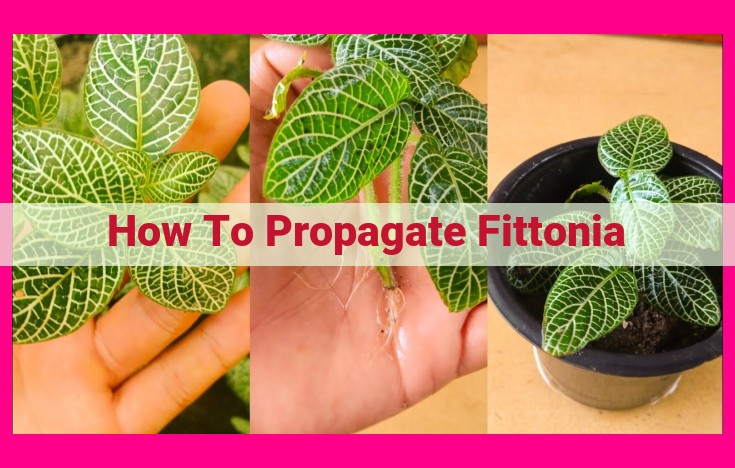Easy Fittonia Propagation Guide: Step-By-Step For Rooting Stem Cuttings

To propagate Fittonia, prepare a potting mix of peat moss and perlite. Take stem cuttings with a sharp knife and remove leaves from the bottom inch. Dip the cuttings in rooting hormone and plant them in the potting mix, ensuring the nodes are covered. Keep the soil moist and provide warmth and humidity by placing a plastic bag over the container. After a few weeks, roots will develop, and you can transplant the new plants into individual pots.
Plant Propagation: A Beginner’s Guide to Growing New Plants
Whether you’re a seasoned gardener or just starting your green-thumbed journey, the ability to propagate plants is an invaluable skill. By learning the essential elements of successful propagation, you can expand your plant collection, share the joy of gardening with others, and create a thriving green oasis in your own backyard.
Materials You’ll Need
Before you embark on your propagation adventure, gather the materials you’ll need to nurture your plant babies. These include:
- Potting mix: A well-draining mix, such as a combination of peat moss, perlite, and vermiculite, provides aeration and supports root growth.
- Containers: Choose pots with drainage holes to prevent waterlogging. They can range from traditional terracotta to biodegradable materials.
- Seeds or cuttings: Determine the propagation method you’ll use and gather the appropriate materials. Seeds are ideal for annuals and perennials, while cuttings are suitable for woody plants like shrubs and trees.
Step-by-Step Propagation Techniques
Seed Sowing:
- Fill your container with potting mix, leaving some space at the top.
- Sow seeds at the depth recommended on the seed packet, using a spoon to create shallow furrows.
- Water lightly and cover the seeds with a fine layer of mix.
- Maintain a warm and moist environment using a humidity tray or plastic wrap.
Cutting Propagation:
- Select a healthy stem from the mother plant and remove a 4-6 inch cutting with sharp pruners.
- Remove the leaves from the bottom 1-2 inches of the cutting.
- Dip the cutting in rooting hormone (optional but recommended) and insert it into a pot filled with a well-draining potting mix.
- Water well and maintain high humidity by covering the pot with a clear plastic bag.
Supporting Factors for Successful Plant Propagation
Beyond the essential elements of materials and techniques, there are crucial supporting factors that can significantly enhance your plant propagation success. These factors include environmental conditions and additional tips to boost propagation rates.
Environmental Factors
The environment plays a vital role in seed germination and root development.
-
Temperature: Different plant species have specific temperature requirements for optimal growth. For example, warm-season plants prefer temperatures between 70-85°F (21-29°C), while cool-season plants thrive in temperatures around 60-75°F (16-24°C).
-
Light: Most plants require ample sunlight for photosynthesis, but the intensity and duration can vary. Some species prefer full sun, while others may tolerate shade. Research the specific light requirements for the plants you’re propagating.
-
Humidity: High humidity levels can promote seed germination and root development. Misting or placing containers in a humid environment can help maintain moisture.
Tips to Enhance Propagation Success
-
Rooting Hormones: These hormones stimulate root growth and can increase success rates. Apply them to cuttings before planting or as directed on the product label.
-
Bottom Heat: Providing bottom heat encourages root development, especially for seeds sown in cooler soil. Heating mats or propagating trays with built-in heat sources can maintain the desired temperature.
-
Sterile Conditions: Clean containers and tools thoroughly before use to minimize the risk of pathogen contamination. This is particularly important for cuttings, as they are prone to disease.
-
Patience: Plant propagation often takes time. Seeds may germinate at different rates, and cuttings may take weeks to develop sufficient roots. Avoid overwatering or disturbing the plants during their establishment phase.
Related Information
Additional Plant Species for Successful Propagation
Once you’ve mastered the essential techniques outlined in this article, you can expand your propagation endeavors to a wide range of other plant species. Many popular and readily available plants can be propagated using the same methods. For example, if you’re a fan of lush greenery, consider trying your hand at propagating ferns or succulents. Or, if you’re looking to beautify your garden with vibrant blooms, try propagating lilies or roses.
Glossary of Essential Plant Propagation Terminology
To enhance your understanding of the propagation process, here’s a brief glossary of key terms:
- Callus: A protective layer of cells that forms over a cutting’s wound to facilitate root development.
- Rooting Medium: The material you insert the cutting into to encourage root growth, such as soil, perlite, or vermiculite.
- Scion: The upper part of a plant used in grafting, which will become the new growth.
By incorporating these additional elements into your plant propagation endeavors, you’ll be well-equipped to successfully propagate many different species and expand your gardening horizons.